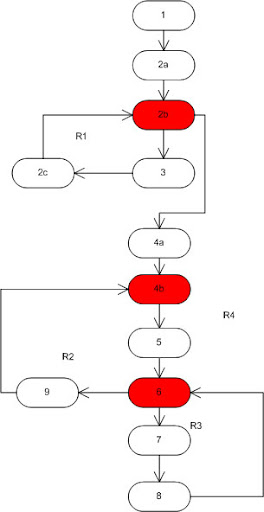Reputation: 2569
Control flow graph & cyclomatic complexity for following procedure
insertion_procedure (int a[], int p [], int N)
{
int i,j,k;
for (i=0; i<=N; i++) p[i] = i;
for (i=2; i<=N; i++)
{
k = p[i];
j = 1;
while (a[p[j-1]] > a[k]) {p[j] = p[j-1]; j--}
p[j] = k;
}
}
I have to find cyclomatic complexity for this code and then suggest some white box test cases and black box test cases. But I am having trouble making a CFG for the code.
Would appreciate some help on test cases as well.
Upvotes: 11
Views: 35326
Answers (3)
Reputation: 335
You can also use McCabe formula M = E-N + 2C
E = edges
N = nodes
C = components
M = cyclomatic complexity
E = 14
N = 12
C = 1
M = 14-12 + 2*1 = 4
Upvotes: 2

Reputation: 103135
Start by numbering the statements:
insertion_procedure (int a[], int p [], int N)
{
(1) Int i,j,k;
(2) for ((2a)i=0; (2b)i<=N; (2c)i++)
(3) p[i] = i;
(4) for ((4a)i=2; (4b)i<=N; (4c)i++)
{
(5) k=p[i];j=1;
(6) while (a[p[j-1]] > a[k]) {
(7) p[j] = p[j-1];
(8) j--
}
(9) p[j] = k;
}
Now you can clearly see which statement executes first and which last etc. so drawing the cfg becomes simple.

Now, to calculate cyclomatic complexity you use one of three methods:
- Count the number of regions on the graph: 4
- No. of predicates (red on graph) + 1 : 3 + 1 = 4
- No of edges - no. of nodes + 2: 14 - 12 + 2 = 4.
Upvotes: 28
Reputation: 1038830
The cyclomatic complexity is 4.
1 for the procedure +1 for the for loop +1 for the while loop +1 for the if condition of the while loop.
Upvotes: 3
Related Questions
- How to draw a Control Flow Graph from this code?
- What would happen if a control flow graph consists of multiple start and/or stop nodes when calculating Cyclomatic Complexity
- Control flow graph of a program
- Convert Control Flow Graph To Directed Acyclic Grraph
- Cyclomatic complexity - draw control flow graph for this java statement
- Control flow graph & cyclomatic complexity
- How to draw a control flow graph for a nested for loop?
- Control flow graph dominance
- Cyclomatic complexity of a code with multiple exit points
- what information we can get from a control flow graph?